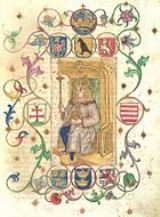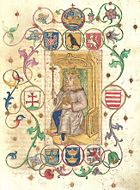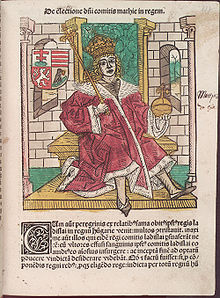
Johannes de Thurocz
Encyclopedia
Johannes de Thurocz (c. 1435 - 1488/1489), was a Hungarian historian in the Kingdom of Hungary, and is the author of Chronicle of the Hungarians
(Chronica Hungarorum), the most extensive 15th century work on Hungary, and the first chronicle on Hungary written by a layman.
(today Turiec
region, Slovakia
) where they were members of a yeoman family recorded since the first half of the 13th century (the village of Nedožery). Johannes' uncle Andreas received a property at Pýr
as a donation from King
Sigismund of Luxembourg, and Johannes' father Peter inherited this estate.
 Thurocz was educated in a Premonstratensian
Thurocz was educated in a Premonstratensian
monastery in Šahy
(Ipolyság), where he studied Latin
and law. In 1465 he appeared in Buda
, as a prosecutor of the Premonstratensian monastery of Šahy. From 1467 to 1475 he served as a notary of the "country judge" Ladislas of Pavlovce, from 1476 to 1486 as the main notary of the country judge Stephen Báthory
at the royal court, and from 1486 to 1488 as a head notary and judge of the royal personnel clerk Thomas Drági. No evidence of any university studies have been preserved, and it is possible that the title "magister" in front of his name was merely a polite title for an official or civil servant.

 The chronicle was written in three main parts:
The chronicle was written in three main parts:
The 1st part is Thurocz's interpretation of a poem by Lorenzo de Monacis of Venice
. It deals with the rule of King Charles II of Hungary, and was probably written on the initiative of Thurocz's superior Stephen of Haserhag (the general notary of the Royal court), or perhaps of the country judge Thomas Drági. Physically, this part is attached to part c) below.
The 2nd part was written in 1486 and describes the deeds of Hungarian kings up to Louis the Great. This part in turn consists of three sub-sections:
The 3rd part describes events from the death of King Charles II the Small (who died in 1386) until the conquest of Vienna
and Wiener Neustadt
by King Matthias Corvinus in August 1487; this can be considered Thurocz's own original work, and was mostly written in early 1487. It was inspired by the famous historico-geographical lexicon Cosmographia by Aeneas Silvius Piccolomini and was based largely on existing diplomatic documents and letters. However, information from the Cosmographia was selected somewhat one-sidedly and haphazardly.
According to his own words in the dedication to his work, Johannes de Turocz had no ambitions to be a historian. In fact, his chronicle contains many errors and omits a number of significant events. Besides more reliable sources, the work relies extensively on oral tradition, folk songs and anecdotes, and contains many references to "miraculous" events and wonders.
Destiny and fortune play a significant role in history as seen by Thurocz.
Like many of his contemporaries he was convinced of the close relationship between human fortune, historical events and the motion of celestial bodies.
Thurocz sought an explanation of a number of events in the moral imperative
. He gave much attention to describing the inner feelings of historical characters, but had an evident tendency to idealize the Hungarian heroes Attila and Matthias Corvinus, while degrading the significance of Hungary's queens.
, (Moravia
) and in Augsburg
. Further editions followed over the following centuries in Frankfurt
, Vienna
, Nagyszombat and Buda
.

[The following paragraph is badly garbled, and needs cleanup]
Illuminations the hand coloured woodcut illustrations (55), the initial letters Inc C 75, accession number F 1450/76 Slovak National Library at Matica slovenská in Turócszentmárton the second edition, Augsburgian, 2. version (variant)
and
Bucharest
, National Library of Romania
, Inc. I 41
Data apariţiei:Datare sigura: 03/07/1488 III Non. Jun. [3 Jun.] 1488
Chronica Hungarorum
Chronica Hungarorum is the title of several works treating the early Hungarian history.-Chronicon Pictum:...
(Chronica Hungarorum), the most extensive 15th century work on Hungary, and the first chronicle on Hungary written by a layman.
Life
Thurocz's parents came from Turóc county (formerly Thurocz), Upper HungaryUpper Hungary
Upper Hungary is the usual English translation for the area that was historically the northern part of the Kingdom of Hungary, now mostly present-day Slovakia...
(today Turiec
Turiec
Turóc , , /comitatus Thurociensis) is the name of a historic administrative county of the Kingdom of Hungary...
region, Slovakia
Slovakia
The Slovak Republic is a landlocked state in Central Europe. It has a population of over five million and an area of about . Slovakia is bordered by the Czech Republic and Austria to the west, Poland to the north, Ukraine to the east and Hungary to the south...
) where they were members of a yeoman family recorded since the first half of the 13th century (the village of Nedožery). Johannes' uncle Andreas received a property at Pýr
Pyr
Pyr may refer to:*Pyruvic acid*Pyridine*Saint Pyr**Caldey Island, called "Ynys Pyr" in Welsh*Pyr *PYR is the IATA code for Andravida airbase*Pyr , a character in the Encantadia franchise...
as a donation from King
King of Hungary
The King of Hungary was the head of state of the Kingdom of Hungary from 1000 to 1918.The style of title "Apostolic King" was confirmed by Pope Clement XIII in 1758 and used afterwards by all the Kings of Hungary, so after this date the kings are referred to as "Apostolic King of...
Sigismund of Luxembourg, and Johannes' father Peter inherited this estate.

Premonstratensian
The Order of Canons Regular of Prémontré, also known as the Premonstratensians, the Norbertines, or in Britain and Ireland as the White Canons , are a Catholic religious order of canons regular founded at Prémontré near Laon in 1120 by Saint Norbert, who later became Archbishop of Magdeburg...
monastery in Šahy
Šahy
Šahy is a town in southern Slovakia, The town has an ethnic Hungarian majority and its population is 7,971 people , with an average age of 42.5.-Geography:...
(Ipolyság), where he studied Latin
Latin
Latin is an Italic language originally spoken in Latium and Ancient Rome. It, along with most European languages, is a descendant of the ancient Proto-Indo-European language. Although it is considered a dead language, a number of scholars and members of the Christian clergy speak it fluently, and...
and law. In 1465 he appeared in Buda
Buda
For detailed information see: History of Buda CastleBuda is the western part of the Hungarian capital Budapest on the west bank of the Danube. The name Buda takes its name from the name of Bleda the Hun ruler, whose name is also Buda in Hungarian.Buda comprises about one-third of Budapest's...
, as a prosecutor of the Premonstratensian monastery of Šahy. From 1467 to 1475 he served as a notary of the "country judge" Ladislas of Pavlovce, from 1476 to 1486 as the main notary of the country judge Stephen Báthory
Stephen Báthory
Stephen Báthory may refer to several noblemen of Hungarian descent:* Stephen III Báthory , Palatine of Hungary* Stephen V Báthory , judge of the Royal Court and Prince of Transylvania...
at the royal court, and from 1486 to 1488 as a head notary and judge of the royal personnel clerk Thomas Drági. No evidence of any university studies have been preserved, and it is possible that the title "magister" in front of his name was merely a polite title for an official or civil servant.
Thurocz's Chronicle


The 1st part is Thurocz's interpretation of a poem by Lorenzo de Monacis of Venice
Venice
Venice is a city in northern Italy which is renowned for the beauty of its setting, its architecture and its artworks. It is the capital of the Veneto region...
. It deals with the rule of King Charles II of Hungary, and was probably written on the initiative of Thurocz's superior Stephen of Haserhag (the general notary of the Royal court), or perhaps of the country judge Thomas Drági. Physically, this part is attached to part c) below.
The 2nd part was written in 1486 and describes the deeds of Hungarian kings up to Louis the Great. This part in turn consists of three sub-sections:
- a) the so-called Hunnish chronicle based on old Hungarian chronicles (Chronicon PictumChronicon PictumThe Chronicon Pictum Pictum, Chronica Picta or Chronica de Gestis Hungarorum) is a medieval illustrated chronicle from the Kingdom of Hungary from the fourteenth century...
, Buda Chronicle) and preserved manuscripts, in which Thurocz attempts to correct the errors of his predecessors; - b) an interpretation of the history of the Hungarian Kingdom from 895 (arrival of the Magyars) until the rule of King Charles I of HungaryCharles I of HungaryCharles I , also known as Charles Robert , was the first King of Hungary and Croatia of the House of Anjou. He was also descended from the old Hungarian Árpád dynasty. His claim to the throne of Hungary was contested by several pretenders...
(1307-42); - c) a history of part of the reign of King Louis I the Great (1342-82), which arose through incorporation of a chronicle written by Ján of Šarišské Sokolovce.
The 3rd part describes events from the death of King Charles II the Small (who died in 1386) until the conquest of Vienna
Vienna
Vienna is the capital and largest city of the Republic of Austria and one of the nine states of Austria. Vienna is Austria's primary city, with a population of about 1.723 million , and is by far the largest city in Austria, as well as its cultural, economic, and political centre...
and Wiener Neustadt
Wiener Neustadt
-Main sights:* The Late-Romanesque Dom, consecrated in 1279 and cathedral from 1469 to 1785. The choir and transept, in Gothic style, are from the 14th century. In the late 15th century 12 statues of the Apostles were added in the apse, while the bust of Cardinal Melchior Klesl is attributed to...
by King Matthias Corvinus in August 1487; this can be considered Thurocz's own original work, and was mostly written in early 1487. It was inspired by the famous historico-geographical lexicon Cosmographia by Aeneas Silvius Piccolomini and was based largely on existing diplomatic documents and letters. However, information from the Cosmographia was selected somewhat one-sidedly and haphazardly.
According to his own words in the dedication to his work, Johannes de Turocz had no ambitions to be a historian. In fact, his chronicle contains many errors and omits a number of significant events. Besides more reliable sources, the work relies extensively on oral tradition, folk songs and anecdotes, and contains many references to "miraculous" events and wonders.
Destiny and fortune play a significant role in history as seen by Thurocz.
Like many of his contemporaries he was convinced of the close relationship between human fortune, historical events and the motion of celestial bodies.
Thurocz sought an explanation of a number of events in the moral imperative
Moral imperative
A moral imperative is a principle originating inside a person's mind that compels that person to act. It is a kind of categorical imperative, as defined by Immanuel Kant. Kant took the imperative to be a dictate of pure reason, in its practical aspect. Not following the moral law was seen to be...
. He gave much attention to describing the inner feelings of historical characters, but had an evident tendency to idealize the Hungarian heroes Attila and Matthias Corvinus, while degrading the significance of Hungary's queens.
Early editions of the chronicle
The first editions of Chronica Hungarorum by Johannes de Thurocz were published in 1488 in BrnoBrno
Brno by population and area is the second largest city in the Czech Republic, the largest Moravian city, and the historical capital city of the Margraviate of Moravia. Brno is the administrative centre of the South Moravian Region where it forms a separate district Brno-City District...
, (Moravia
Moravia
Moravia is a historical region in Central Europe in the east of the Czech Republic, and one of the former Czech lands, together with Bohemia and Silesia. It takes its name from the Morava River which rises in the northwest of the region...
) and in Augsburg
Augsburg
Augsburg is a city in the south-west of Bavaria, Germany. It is a university town and home of the Regierungsbezirk Schwaben and the Bezirk Schwaben. Augsburg is an urban district and home to the institutions of the Landkreis Augsburg. It is, as of 2008, the third-largest city in Bavaria with a...
. Further editions followed over the following centuries in Frankfurt
Frankfurt
Frankfurt am Main , commonly known simply as Frankfurt, is the largest city in the German state of Hesse and the fifth-largest city in Germany, with a 2010 population of 688,249. The urban area had an estimated population of 2,300,000 in 2010...
, Vienna
Vienna
Vienna is the capital and largest city of the Republic of Austria and one of the nine states of Austria. Vienna is Austria's primary city, with a population of about 1.723 million , and is by far the largest city in Austria, as well as its cultural, economic, and political centre...
, Nagyszombat and Buda
Buda
For detailed information see: History of Buda CastleBuda is the western part of the Hungarian capital Budapest on the west bank of the Danube. The name Buda takes its name from the name of Bleda the Hun ruler, whose name is also Buda in Hungarian.Buda comprises about one-third of Budapest's...
.

- The BrnoBrnoBrno by population and area is the second largest city in the Czech Republic, the largest Moravian city, and the historical capital city of the Margraviate of Moravia. Brno is the administrative centre of the South Moravian Region where it forms a separate district Brno-City District...
edition, published 20 March 1488, printed by Couradus Stahel and Matthias Preinlein. One copy is preserved at the Biblioteca Mănăstirii Brâncoveanu in RomaniaRomaniaRomania is a country located at the crossroads of Central and Southeastern Europe, on the Lower Danube, within and outside the Carpathian arch, bordering on the Black Sea...
; a second at GrazGrazThe more recent population figures do not give the whole picture as only people with principal residence status are counted and people with secondary residence status are not. Most of the people with secondary residence status in Graz are students...
University Library, Austria; and a third in BraşovBrasovBrașov is a city in Romania and the capital of Brașov County.According to the last Romanian census, from 2002, there were 284,596 people living within the city of Brașov, making it the 8th most populated city in Romania....
, Romania (Parohia evanghelică C. A. Biserica NeagrăBiserica NeagraBiserica Neagră or Black Church is a cathedral in Brașov, a city in south-eastern Transylvania, Romania. It was built by the German community of the city and stands as the main Gothic style monument in the country, as well as being the largest and one of the most important Lutheran places of...
1251/2).
- The AugsburgAugsburgAugsburg is a city in the south-west of Bavaria, Germany. It is a university town and home of the Regierungsbezirk Schwaben and the Bezirk Schwaben. Augsburg is an urban district and home to the institutions of the Landkreis Augsburg. It is, as of 2008, the third-largest city in Bavaria with a...
(Augusta Vindelicorum) edition, dated [3 Jun.] 1488 Publisher Erhard Ratdolt for Theobald Feger, a citizen of Buda.
[The following paragraph is badly garbled, and needs cleanup]
Illuminations the hand coloured woodcut illustrations (55), the initial letters Inc C 75, accession number F 1450/76 Slovak National Library at Matica slovenská in Turócszentmárton the second edition, Augsburgian, 2. version (variant)
and
Bucharest
Bucharest
Bucharest is the capital municipality, cultural, industrial, and financial centre of Romania. It is the largest city in Romania, located in the southeast of the country, at , and lies on the banks of the Dâmbovița River....
, National Library of Romania
National Library of Romania
Biblioteca Naţională a României is the National Library of Romania. It is intended to be the repository of all that is published in Romania.-History:...
, Inc. I 41
Data apariţiei:Datare sigura: 03/07/1488 III Non. Jun. [3 Jun.] 1488
- German 1490 manuscript - one copy at Heidelberg (Cod. Pal. germ. 156); another at Cambridge (Mass.), Houghton Libr., (Ms. Ger. 43 [formerly Nikolsburg, Fürstl. Dietrichsteinsche Bibl., Cod. II 138]).
See also
- Sources of early Hungarian history
- Chronica HungarorumChronica HungarorumChronica Hungarorum is the title of several works treating the early Hungarian history.-Chronicon Pictum:...
External links
- http://digi.ub.uni-heidelberg.de/diglit/cpg156/0001The German illuminated manuscriptIlluminated manuscriptAn illuminated manuscript is a manuscript in which the text is supplemented by the addition of decoration, such as decorated initials, borders and miniature illustrations...
and the German text] - The original Latin text of the chronicle

